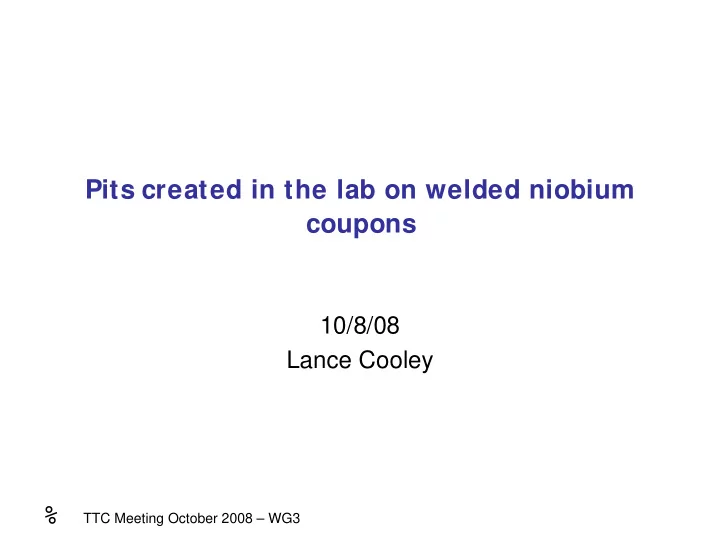

Pits created in the lab on welded niobium coupons 10/8/08 Lance Cooley f TTC Meeting October 2008 – WG3
Acknowledgments • Welding – Mike Foley, Sciaky • EP – Charlie Cooper, Donna Hicks, Dave Burk, Rob Schuessler, Chad Thompson – 6 hours in sweaty chemistry suits… • Photos – Dave Burk, Chad Thompson, Dmitri Sergatskov, Charlie Cooper, Rob Scheussler, Lance Cooley f TTC Meeting October 2008 – WG3
Overview • Corners of Nb sheets used in 9AES001 were used to simulate an equator weld • They were machined to same contour as equator joint and given same weld prep, then welded • After welding, inspection did not reveal defects • EP was done in a lab beaker setup that attempted to use same parameters as was used on 9AES001 • Defects (pits) were observed on both coupons after EP • The defects were found to have common features f TTC Meeting October 2008 – WG3
Equator Sample Weld Parameters Weld info All four weld samples were prepared with two tack welds (one tack weld at each end of the joint), followed by a seal weld pass to get heat into the pieces to be joined. The tack and seal weld parameters for all four samples were: Tack Weld 50 KVolts 20 mA Focus 365 ( ~ 0.5 inches above joint) 30 inches per minute (ipm) material feed rate Seal Weld 50 KVolts • Welds done by Mike 25 mA (1.0 sec dwell) followed by 25 mA for weld Focus 376 ( ~ 1.5 inches above joint) 18 inches per minute (ipm) material feed rate Foley at Sciaky E-beam oscillating on 0.040” diameter circular path at 100 Hz puddle frequency (PF) The parameters for the final weld pass on each sample were: • Weld parameters were SAMPLE 1 2 3 4 EB voltage 50 KV 50 KV 50 KV 50KV as close as possible to EB current 45 mA 43 mA 43 mA 43 mA actual parameters used (1.0 sec dwell) (0.5 sec dwell) (0.5 sec dwell) (0.5 sec dwell) 44 mA for weld 43 mA for weld 41 mA for weld 43 mA for weld on 9AES001 Focus 378 378 378 378 ~ 1.8” above joint • 3 passes: tack, seal, full Feed Rate 18 ipm 18 ipm 18 ipm 18 ipm penetration Oscillation E-beam oscillating in 0.050” diameter circular path at 100 Hz PF 3.1 x 10 -5 Torr 3.5 x 10 -5 Torr 2.0 x 10 -5 Torr 4.2 x 10 -5 Torr Vacuum Temperature ~ 123 0 F ~ 106 0 F ~ 112 0 F ~ 98 0 F Each sample was allowed to cool down for 10 minutes under vacuum. The weld chamber was then backfilled with nitrogen to a level of ~ 25 Torr and the sample was allowed to cool for another 10 minutes. The temperature of the part was recorded immediately after f the weld chamber was opened to atmosphere. TTC Meeting October 2008 – WG3
EP details – caution! System not optimized Both samples Sample 1A 6-2 • Nb and Al parallel plates in a • 210 µm total removal in 6 hrs (0.6 µm min -1 ) beaker, stir bar at the bottom. Beaker then sat in a chilled • 14.5 V, not well controlled at water bath. first • Niobium wire used to suspend 2.3 to 3.2 A (60-80 A cm -2 ) • niobium sample – wire etched • Temp rose 18 to 32 °C through several times Sample 1-1 • Weld side faced Al cathode; • 110 µm total in 3.5 hrs (0.5 µm both sides were exposed min -1 ) • Temperature not under control • 14.5 V, 2.3 to 3.2 A • Current oscillations at fixed • 17 to 37 °C voltage once plateau reached f TTC Meeting October 2008 – WG3
Most white spots are scale (sulfur?) ~HAZ Pit row Pit 1 Stains Z A H ~ Pit 3 Pit 2 • 210 total µm removed • 110 total µm removed (total) f TTC Meeting October 2008 – WG3
Cross-section of the “HAZ” 1 mm Water stain Area marked “HAZ” in previous slide f TTC Meeting October 2008 – WG3
Pit 1 Pit 1 is a whopper on the weld – 50 µm deep!! Profile is across red line Imaged using Keyence 3D microscopy
Pit 1 contour map: Notice the “moat” around the peaks f TTC Meeting October 2008 – WG3
Pit 1 contour map: Notice the “moat” around the peaks f TTC Meeting October 2008 – WG3
Pit 2 Again, notice “moat” around peak Grain boundaries 14 µm height, 45 µm span f TTC Meeting October 2008 – WG3
Pit 3 6 µm height, 51 µm span f TTC Meeting October 2008 – WG3
Pit 3 f TTC Meeting October 2008 – WG3
Pit rows that occur at the edge of the HAZ f TTC Meeting October 2008 – WG3
Pit row – again peaks are surrounded by moat f TTC Meeting October 2008 – WG3
Common themes and summary observations • Pits are really peaks surrounded by a circular trough. • ~10 um tall and ~50 um diameter pits are already formed at 110 µm removal • Grain boundaries lead in to one pit – others too? This was seen in 9AES001. • We’re fairly confident that welding and weld prep was done very carefully and is not a source of flaws. • EP was in no way optimized or under control. • Florida State U. is dissecting pits and doing chemical analysis now f TTC Meeting October 2008 – WG3
Recommend
More recommend